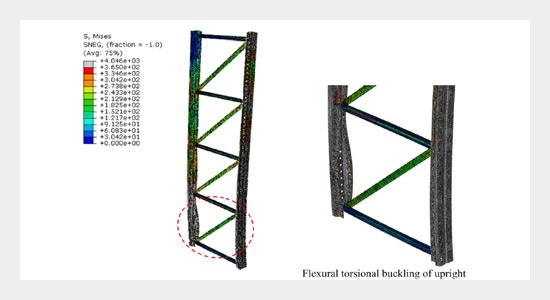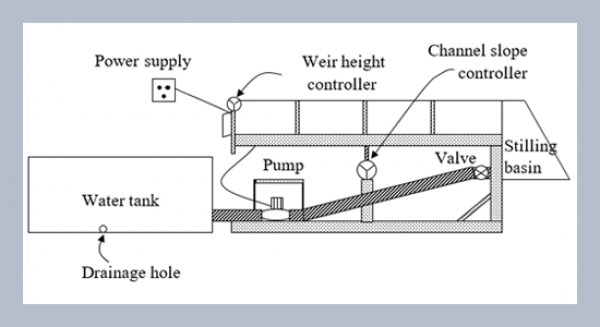C. N. Thombarea, K. K. Sanglea, V. M. Mohitkarb, S. B. Kharmalec* aStructural Engineering Department, Veermata Jijabai Technological Institute, Matunga, Mumbai, India
bMaharashtra State Board of Technical Education, Bandra (East) Mumbai, India
cApplied Mechanics, Government College of Engineering and Research, Avasari (Kd), Pune, Maharashtra, India
Download Citation:
|
Download PDF
Individual components of cold-formed storage rack system are most vulnerable to local and torsional buckling under gravity as well as lateral loads.The capacity-based design of cold-formed storage rack system consists of deterministic allocation of strength and ductility in the structural elements and performance evaluation by suitable techniques. Nonlinear time history analysis (NTHA) and nonlinear static pushover analysis (NSPA) are most commonly followed techniques for seismic performance evaluation of any structural systems. Although, NTHA is the most accurate method of seismic demand prediction and performance evaluation, it is computationally heavy and even requires the selection and employment of an appropriate set of ground motions. This paper deals with analytical investigation of efficient configuration of conventional pallet racking system on the basis of seismic performance by using NSPA. This analytical study on conventional pallet racking system subjected to lateral loads is focused: i) to identify the local buckling failure modes of components of storage rack systems, ii) to evaluate the effect of local buckling on ultimate lateral load carrying capacity, and iii) to propose structural alterations for components of rack system so as to obtain most efficient configuration of conventional pallet racking system. Two different configurations of conventional pallet racking system are modeled and analyzed on the general purpose FE platform under monotonic unidirectional lateral loads. The results of NSPA show that pallet racking system with horizontal and inclined bracing is more efficient as evidenced from good estimates of the overall displacement, base shear and yielding capacities.ABSTRACT
Keywords:
Pallet racks; cold-formed steel; nonlinear push-over analysis; base shear.
Share this article with your colleagues
[1] Rack Manufacturers Institute, 2008. “Specifications for the Design, Testing and Utilization of Industrial Steel Storage Racks”. Rack Manufacturers Institute, USA.REFERENCES
[2] Applied Technology Council, 1996. “Seismic Evaluation and Retrofit of Concrete Buildings, Report ATC-40”.Redwood City, U.S.A. (also Report SSC 96-01, Seismic Safety Commission, State of California, Sacramento, U.S.A.).
[3] Krawinkler, H. and Seneviratna, G. P. D. K. 1998. Pros and cons of a pushover analysis of seismic performance evaluation. Engineering Structures, 20, 4-6:452-464.
[4] Asawasongkram, N., Chomchuen, P., and Premthamkorn, P. 2014. Seismic performance evaluation of steel storage racks using experimental results of beam-to-column connection. 2nd European Conference on Earthquake Engineering and Seismology, Istanbul Aug.25-29, 2014.
[5] Chopra, A.K. and Goel, R.K. 2002. A modal pushover analysis procedure for estimating seismic demands for buildings. Earthquake Engineering and Structural Dynamics, 31, 3: 561–582.
[6] Kalkan, E. and Chopra, A. K. 2011. Modal-pushover-based ground-motion scaling procedure. Journal of Structural Engineering. 137, 3: 298–310.
[7] Fajfar, P. 2000. A nonlinear analysis method for performance based seismic design. Earthquake Spectra, 16, 3: 573-592.
[8] Bureau of Indian Standards, 2002. IS: 1893 (Part I): 2002. “Criteria for Earthquake Resistant Design of Structures”. Bureau of Indian Standards, New Delhi
[9] Sangle, K. K. Bajoria, K. M., and Talicoti, R. S. 2011.Stability and dynamic analysis of cold-formed storage rack structures with semi rigid connections. International Journal of Structural Stability and Dynamics, 11,6: 1059-1088.
[10] ANSYS, Inc., 2006 ANSYS version 8.1 On-line User’s Manual.
[11] Sasaki, K. K., Freeman, S. A., and Paret, T. F. 1998. Multi-mode pushover (MMP)-A method to identify the effects of higher modes in a pushover analysis. 6th U.S. Conference on Earthquake Engineering, 1-12.
[12] Kalavagunta, S., Naganathan, S., and Mustaphaet, K. N. B. 2012. Pushover analysis for cold formed storage rack structures. Jordan Journal of Civil Engineering, 6, 4: 489-500.
[13] Moghadam, A. S. and Tso, W. K. 2000. 3-D pushover analysis for damage assessment of buildings. Journal of Seismology and Earthquake Engineering, 2, 3: 23-31.
[14] Moen, C. D. and Schafer, B. W. 2006. Impact of holes on the elastic buckling of cold-formed steel columns. Proceeding of Eighteenth International Specialty Conference on Cold-Formed Steel Structures, Paper 2, 269-283. (Retrieved from http://scholarsmine.mst.edu/isccss/18iccfss/18iccfss-session4/2
[15] Abaqus. 2012.“ABAQUS version 6.12”. ABAQUS Inc. Pawtucket, RI, USA
ARTICLE INFORMATION
Received:
2015-05-01
Revised:
2015-12-28
Accepted:
2015-12-30
Available Online:
2016-03-01
Thombare, C.N., Sangle, K.K., Mohitkar, V.M., Kharmale, S.B. 2016. Nonlinear static pushover analysis of Cold-Formed steel storage rack structures. International Journal of Applied Science and Engineering, 14, 13–26. https://doi.org/10.6703/IJASE.2016.14(1).13
Cite this article:















